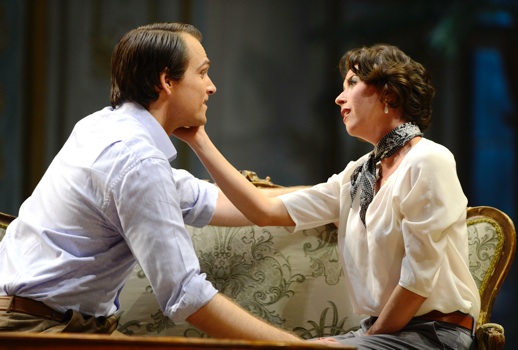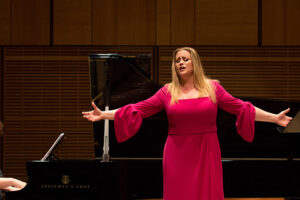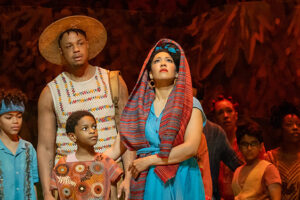

That’s an odd word, but an indication that Verdi had to be careful about linking his work to the dangerously explicit La Dame aux camélias, a French best-seller and hit play about a young courtesan who loves too well and dies too young of a disease that in women was attributed to sexual excess. (The opera was written in 1853 but the etiology of TB, or phthisis as it was called—tisi in Italian—was not understood until 1882. There was no certain cure until 1946.)
This run was Oropesa’s first attempt at the role. Of Cuban descent, she is a native of New Orleans and a graduate of the Met’s Lindemann program. Pretty and girlish with an elegant figure, she was a last minute Susanna in the new production of Le nozze di Figaro there in 2007, and was an especially lovely Nannetta in Falstaff in 2013. Those are difficult parts but Violetta is a diva role, one of the most demanding and exposed in the popular repertory and one that most female aspirants to operatic glory have tried.
It’s long and ranges from difficult coloratura in act one to high romantic outpourings later and has one of the most sustained death scenes in Italian opera (La traviata was the first opera where a character died from a specific disease, however unspeakable it was at the time.) It is a serious challenge that needs everything a soprano has.
Oropesa is by nature a typical “coloratura”. Her voice is high set and light. After warming up, thereby losing a slight flutter, she showed a most beautiful but soft-focused one. Many “born” coloraturas have an edge to the sound and those who try heavier roles often cultivate that edge, called “squillo” in Italian. It helps them get their voices out into a big theater—and the Academy of Music, even if about half the size of the Met, is vast enough. Squillo allows a lighter soprano some thrust and bite in the more dramatic eruptions this role requires.
Oropesa, though, has kept a sweet and limpid sound. She reminded me from time to time of the but forgotten Graziella Pareto, a very famous “coloratura” Violetta, who Thomas Beecham remarked was the best he had ever seen. Oropesa’s tone has a built in caress, a timbre that has a penumbra of vulnerability that draws one’s ear rather than attacking it—something that Marilyn Horne once said was the mark of a great singer.
Yes, Oropesa managed a very good but not excessively showy “Sempre libera” in act one and even ended it with a clean, easy E-flat in alt, but one taken in tempo and as part of the line. That, however, was not the most memorable part of that act. She sang the recitative “È strano! È strano!” with extreme sensitivity, then phrased an exquisitely soft, fine-spun “Ah fors’è lui”. It was musically immaculate and emotionally inward.
She “graded” dynamics, something that is now very rare. She moved from very, very soft, through soft, to a slight forte, saving her loudest singing for the outpouring of “Ah quel amor, quel amore ch’è palpito.” She was enacting in vocal terms Violetta’s intimate awareness of the strange emotions she is feeling and then, finally, coming to an understanding, that unexpectedly, in a second, her life has changed. It was beautiful singing and it was utterly human. (Also, in practical terms, it allowed for the climactic phrases to sound with relative force.)
After act one, Violetta becomes a lyric role, testing a light soprano with outbursts and extended singing in the middle. For the most part Oropesa did very well. In the long scene with her lover’s father (sung here by Stephen Powell) she handled her voice expertly, spinning out long lines, projecting by making the most of shifting rhythms. For example, she marked the 6/8 rhythm in “Non sapete, quale affetto…”, taking seriously the markings vivacissimo/agitato and actually executing the pattern of two staccato eighths followed by two linked 16ths and quarter note, the first 16th accented) rather than artificially darkening or forcing her voice.
Once again, she graded dynamics, despite her soft-grained sound, noting the marking of p for the first phrase and pp for its repetition. The spin on her tone, the arched phrases and a simple sincerity were wonderful in “Dite alla giovane,” though to be sure a little more heft wouldn’t have come amiss either there or in the following more dynamic section (which begins with one of those outbursts, the cry of “Morrò”. But it’s true that clear words, strong rhythms and firmly judged phrases can send a voice “travelling” through the theater.
The one point where she did less well involved partially, stage business, and partially, a vocal climax. There is the great section, almost not vocal with its heartbreaking clarinet solo, where Violetta writes her letter lying to Alfredo about no longer loving him. Here Oropesa needed either a director’s help, or simply more experience.
I remember this being devastating as played by Victoria de los Angeles, Patricia Brooks (actually in vocal format not so different from Oropesa and the most moving Violetta I’ve ever seen) and Renata Scotto. But it was somewhat anonymous here. Alfredo (Alek Shrader) interrupts her and Violetta, knowing she is bidding him farewell, with all her force begs him to love her with the same abandon with which she loves him (“Amami Alfredo”). Though Oropesa hung onto Shrader for dear life for extra support and the conductor, Corrado Rovaris, kept the orchestra way down, she didn’t have enough voice for this. It is the one moment she clearly needs to solve to go on to bigger houses.
In the second scene of act two, Flora’s party, where Violetta and Alfredo have a violent confrontation, directorial and design issues didn’t help her, though her precise beautifully tuned and shaped entrance in the finale on “Alfredo, Alfredo…” was wonderful.
Similar production problems afflicted act three. She was not memorable reading the letter, but Rovaris allowed her both verses of “Addio del passato” and once again she showed enormous artistry. It wasn’t only her death-haunted tone floating through a house holding its breath, it was her musical imagination and elegance that landed.
It sounded as though she had listened to Luisa Tetrazzini’s recording of (both verses of) this aria. That legendary artist does not decorate the second verse (as Verdi might have expected) but she does make much of the different words, using rhythm and phrasing to make slight but telling differences and to build a powerful effect. Oropesa, though she had her own ideas, did much the same and very movingly indeed. Her exquisite phrasing of the lines, her perfect placing of the E5s, and her inwardness were wonderful. She and Shrader were marvelous when they really blended their voices in “Parigi o cara”.
Hemmed in by a big bed on a shallow stage she perhaps made less of “Ah, gran dio, morir si giovane” but she did well enough and her floating through Violetta’s giving Alfredo her picture was heartbreaking
Violetta has one final big moment which begins with her speaking. She says that she feels revived, reborn, and cries, “I am returning to life.” Who can forget Angela Gheorghiu in Richard Eyre’s production at Covent Garden running around the stage during this section, a behavior that had been observed in actual patients dying of TB in the 19th century)? But Oropesa was left on her own to fall sideways, with the big bed right behind her!
Schrader has a beautiful but light voice which he pushed to make a bigger sound. He is a wonderful musician, though. “De’ miei bollenti spiriti” never gets much applause (it didn’t for Pavarotti or Alfredo Kraus either) but it’s murder to sing, and he phrased it, kept excellent time and stayed in tune, all actually rare. He also managed a real if short high C at the end of his cabaletta. He’s a nice looking man who was directed to slouch and pout like an adolescent and in scene one of act two was stuck with a tennis racket. Also he either jumped his cue or his entrance in act three was badly botched—he was standing awkwardly on stage long before the character—supposedly running to embrace Violetta—needs to be.
Powell is one of the wonderful American baritones the Met casting people seem to ignore but who is infinitely better than the carnival barkers they usually hire. He may have been a little unwell on this occasion because he clamped a heavy cover on the top of his voice—but when he opened for a few moments here and there his familiar magnificence of sound rang out. He too was oddly directed. I have never seen Violetta and Giorgio Germont hug so much in my life!

Given all the vocal schools in town, this company can usually count on good voices in smaller roles. Here though, the best was the fine sounding Andrew Bogard as Doctor Grenvil (whom Alfredo is asked to rough up, I guess because he hasn’t cured an incurable disease!)
Feraris has been an uneven conductor in my experience, superlative here and wonderful in last season’s magnificent Yardbird but jittery in Don Carlo and routine in Nabucco.
It’s not the easiest task judging regional opera productions. One can never know how much rehearsal there was, and whether what there was mainly went to blocking rather than an exploration of characters and their interactions. The sets imported from Bucharest must have been a bargain, as they added nothing and the concept of the walls closing in simply trapped the singers into impossibly awkward positions in the last two scenes.
The action was updated to the 1950’s when TB would have been curable. But why the camp of having Violetta’s female party guests do the Macarena at the start of the Brindisi? Where were the gypsy girls at Flora’s party? Could the company not afford even a couple of pretty extras? But there were some male extras who as “matadors” stripped their shirts off, all of this with no room for them to suggest availability either to the women or some of the men, which surely is the point of the number.
One can no longer escape the staging of the prelude to act one of Traviata but why wreck the marvelous prelude to act three, giving Annina palpably fake “business,” when the emphasis should be on the orchestra’s depiction of Violetta’s frailty?
But the news here wasn’t the iffy production. It was Oropesa, a remarkable artist with stunning gifts and already a touch of greatness.
Photos: Kelly & Massa

























Comments